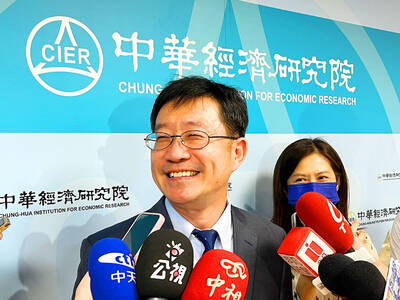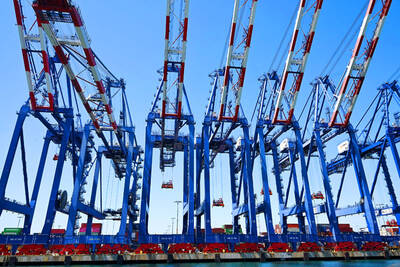China can finance the US economy because its workforce is large relative to children and old people, a new analysis suggests in an attempt to solve a mystery why Beijing is a major net creditor rather than a borrower as emerging economies usually are.
This strong ratio of workers to dependents is set to last for at least 15 years, the study says, although the net benefit for China will decline as the burden of old people creeps up while the cost of children remains steady.
The personal research by economists writing in a publication of the Basel-based Bank for International Settlements also implies that the workforce is skewed, with young people who have left a child-bulge bracket up to the age of 15 now boosting the workforce.

PHOTO: BLOOMBERG
And they are saving money substantially.
Economists Ma Guonan (馬國南) and Zhou Haiwen (周海文) argue that China’s savings glut can in part be explained by its low “youth dependency ratio,” that is, the ratio of those below the age of 15 to the working age population.
A country’s “old-age dependency ratio,” by contrast, compares the percentage of pensioners over 65 to the work force.
“One striking feature of China’s demographic transition during 1985-2007 is that its youth dependency ratio fell by half while its old-age dependency increased only slightly, leaving the overall dependence unchanged,” the report said.
The suggestion that demographics are a hidden key to why China is able to buy assets around the world while holding huge amounts of US government debt casts surprising light on an issue at the heart of long-standing tension between the US and China.
It also gives a new perspective to the view long held by many economists that so-called global imbalances, principally the US trade deficit with China matched by import earnings for China, would be a factor leading to a crisis of the kind the world is now experiencing.
The conventional view is that the massive Chinese investment abroad is a way of “sterilizing” the country’s huge earnings from exports or preventing them from causing inflation and driving up the yuan. The export surpluses are an undisputed fact; however, the new research suggests that they are not the only big source of surplus funding available to China.
For the US, struggling to spark a recovery, the stakes are high, a point apparently driven home by senior US officials during talks in Washington last week with Chinese Vice Premier Wang Qishan (王岐山).
US Treasury Secretary Timothy Geithner urged China to shift its economy away from exports and toward domestic demand to strengthen the ailing global economy. He was in essence asking the Chinese to save less and import more.
The research by Ma and Zhou offers insights into why China has funds to invest abroad and points to a high ratio of personal savings and a reduction of government borrowing as important factors.
These, they say, are driven by demographics and enable the emerging Chinese powerhouse to export capital instead of importing it, thereby defying classical economic theory.
FREED
With a relatively low percentage of the population under 15, the Chinese government is freed from having to spend vast sums on child-related services and can go abroad in search of securities and companies to buy, according to this analysis.
The BIS, known as the central bankers’ central bank, circulated the report last week, adding that the arguments developed by the authors do not necessarily reflect those of the bank.
A net debtor in 1999, China has since become a major net creditor and is likely to remain so until 2025, according to the study.
The country’s “net foreign asset position” (NFA) — the difference between its overseas assets and liabilities — came to 30 percent of its GDP in 2007 and amounted to more than US$1 trillion.
In absolute terms, China’s NFA status was second only to that of Japan.
The authors of the study describe the turnaround in China’s external financial situation as “puzzling,” given its relatively low per capita income level (US$2,500) and its sizzling growth of recent years.
“A faster growing economy tends to attract more capital inflows,” the report noted, adding that “by conventional wisdom China should ... be a significant importer of foreign savings.”
ZEALOUS SAVERS
But that is not what has happened, the report contends, largely because the Chinese are zealous savers rather than consumers of foreign goods.
And those savings are increasingly being invested abroad, notably in the US, where Chinese holdings in US Treasury bonds now amount to more than US$800 billion.
“Given China’s growing role in the global financial system, the stakes are high, not only for China but for the rest of the world,” the authors contend.
In 1985, according to the study, for every 100 people in work, just over 45 children aged under 15 were dependent on them.
By 2005, 100 workers were supporting slightly fewer than 15 youngsters.
A reduced obligation to meet youth-related needs, the report said, should boost overall savings and drive net capital outflow.
“This is because a lower youth dependency could lead to reduced investment in housing, schools and hospitals,” the report says.
China’s overall dependency ratio, expressed as all children under 15 plus pensioners over 65 divided by all workers in between, is also falling.
The labor force in China has, in effect, been growing faster than the population that depends on it, further strengthening savings.
The study found that China’s overall dependency fell from 55 percent in 1985 to 38 percent in 2007.
A declining dependency ratio tends to lift household savings rates while increasing the labor supply, thereby acting as a constraint on wage rises.
Government savings are also enhanced as less money is spent on health care and pensions.
DEBT
The report also pointed to a reduction of Chinese government debt, which hit a peak of 30 percent of output in 2002. It noted that, conversely, a rise in official debt would tend to reduce domestic savings and increase foreign borrowing.
While Beijing is on course to remain a net creditor until 2025, youth dependency is unlikely to fall further and so “may thus cease to be a main driver” of China’s external financial position.
But the old-age dependency ratio is also forecast to double to 20 percent in the next 15 years, cutting spare funds for investment abroad.
China’s foreign asset position “is expected to adjust gradually, facilitated by continued strong economic growth and a more flexible renminbi.”
And “this should assist an orderly global rebalancing without creating excess stress on the rest of the world during the transition.”

IN THE AIR: While most companies said they were committed to North American operations, some added that production and costs would depend on the outcome of a US trade probe Leading local contract electronics makers Wistron Corp (緯創), Quanta Computer Inc (廣達), Inventec Corp (英業達) and Compal Electronics Inc (仁寶) are to maintain their North American expansion plans, despite Washington’s 20 percent tariff on Taiwanese goods. Wistron said it has long maintained a presence in the US, while distributing production across Taiwan, North America, Southeast Asia and Europe. The company is in talks with customers to align capacity with their site preferences, a company official told the Taipei Times by telephone on Friday. The company is still in talks with clients over who would bear the tariff costs, with the outcome pending further

WEAKER ACTIVITY: The sharpest deterioration was seen in the electronics and optical components sector, with the production index falling 13.2 points to 44.5 Taiwan’s manufacturing sector last month contracted for a second consecutive month, with the purchasing managers’ index (PMI) slipping to 48, reflecting ongoing caution over trade uncertainties, the Chung-Hua Institution for Economic Research (CIER, 中華經濟研究院) said yesterday. The decline reflects growing caution among companies amid uncertainty surrounding US tariffs, semiconductor duties and automotive import levies, and it is also likely linked to fading front-loading activity, CIER president Lien Hsien-ming (連賢明) said. “Some clients have started shifting orders to Southeast Asian countries where tariff regimes are already clear,” Lien told a news conference. Firms across the supply chain are also lowering stock levels to mitigate

NEGOTIATIONS: Semiconductors play an outsized role in Taiwan’s industrial and economic development and are a major driver of the Taiwan-US trade imbalance With US President Donald Trump threatening to impose tariffs on semiconductors, Taiwan is expected to face a significant challenge, as information and communications technology (ICT) products account for more than 70 percent of its exports to the US, Chung-Hua Institution for Economic Research (CIER, 中華經濟研究院) president Lien Hsien-ming (連賢明) said on Friday. Compared with other countries, semiconductors play a disproportionately large role in Taiwan’s industrial and economic development, Lien said. As the sixth-largest contributor to the US trade deficit, Taiwan recorded a US$73.9 billion trade surplus with the US last year — up from US$47.8 billion in 2023 — driven by strong

RESHAPING COMMERCE: Major industrialized economies accepted 15 percent duties on their products, while charges on items from Mexico, Canada and China are even bigger US President Donald Trump has unveiled a slew of new tariffs that boosted the average US rate on goods from across the world, forging ahead with his turbulent effort to reshape international commerce. The baseline rates for many trading partners remain unchanged at 10 percent from the duties Trump imposed in April, easing the worst fears of investors after the president had previously said they could double. Yet his move to raise tariffs on some Canadian goods to 35 percent threatens to inject fresh tensions into an already strained relationship, while nations such as Switzerland and New Zealand also saw increased